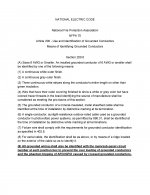RatherBeFishin
Member
- Location
- New York
- Occupation
- Electrical apprentice
Does anyone see an issue with taking two circuits off separate breakers and splicing them together with a single tail off to one breaker to make space for adding a ckt to that panel?
Or is adding a tandem the better option? I’ve seen both plenty of times.
Of course as long as each ckt you combine is a small load and each ckt has their own neutral. A multiwire splice would overload the neutral on one phase but the other method you’d have a separate neutral return for both hots
Or is adding a tandem the better option? I’ve seen both plenty of times.
Of course as long as each ckt you combine is a small load and each ckt has their own neutral. A multiwire splice would overload the neutral on one phase but the other method you’d have a separate neutral return for both hots


